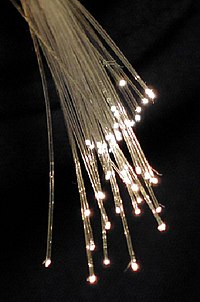
Photo from wikipedia
Today's lowest-loss hollow core fibers are based on antiresonance guidance. They have been shown both theoretically and experimentally to have very low levels of backscattering arising from the fiber structure… Click to show full abstract
Today's lowest-loss hollow core fibers are based on antiresonance guidance. They have been shown both theoretically and experimentally to have very low levels of backscattering arising from the fiber structure - 45 dB below that of traditional optical fibers with a solid silica glass core. This makes their longitudinal characterization using conventional reflectometric techniques very challenging. However, it was recently estimated that when filled with air, their backscattering coefficient increases to about 30 dB below that of standard solid core fibers. This level should be measurable with commercially available high performance optical time domain reflectometers (OTDR). Here we demonstrate - for the first time to the best of our knowledge - the measurement of backscattering from the air inside a hollow core fiber. We show that the characterization of multi-km long hollow core fibers with 15 m spatial resolution is possible using a commercial OTDR instrument. To benefit from its full dynamic range, we strongly suppress the 4% back-reflections that ordinarily occur at the OTDR's standard fiber output when directly-connected to a hollow core fiber. Furthermore, low coupling loss into the hollow core fiber (0.3 dB in our experiment) also helps to maximize the achievable OTDR signal-to-noise ratio. This approach enables distributed characterization and fault-finding in low-loss hollow core fibers, a topic of increasing importance as these fibers are now starting to be installed in commercial optical communication networks.
Journal Title: Optics express
Year Published: 2022
Link to full text (if available)
Share on Social Media: Sign Up to like & get
recommendations!